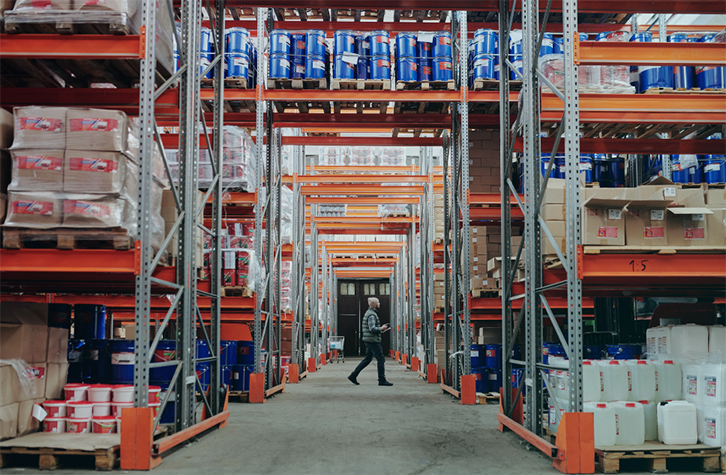How to Cope with (Over)full Warehouses?
Last edited on Jan, 09 2024 09:50:20 AM
Reading time: 6 minutes
Written by Bart Stuve
Table of contents
Share article

Effectively managing (over)full warehouses poses a significant operational challenge. Warehousing inherently involves complexities, and the current trend, particularly in areas like the hinterland of the port of Rotterdam and other strategic logistics hubs, is the accumulation of goods leading to warehouses reaching maximum capacities. This makes it harder to work efficiently and comes with its own set of problems. That raises the question: ‘how to cope with (over)full warehouses?’
This development is partly a consequence of the aftermath of the COVID-19 crisis. During the lockdowns, dining out and in-person shopping were restricted, but online ordering of goods was unrestricted. This resulted in a high demand for various products, causing the logistical system to struggle to meet the demand. Businesses and retailers procured their merchandise well in advance, resulting in the saturation of all distribution centres in the hinterland of major ports and, more recently, inland terminals, with goods ordered ahead of schedule.
If current demand and buying confidence were still as robust as during the pandemic, this might not be a major concern. However, the combination of inflation and soaring energy prices has made people more cautious about their spending. As a result, goods are staying in warehouses longer than usual, causing efficiency and optimisation challenges in warehouse management.
While companies have limited control over macroeconomic factors, they can secure a competitive edge by concentrating on optimisations in their warehouse layout and/or operational methods, enhancing the flow of goods within their warehouses. Read on to find out how to cope with (over)full warehouses and the role Emixa can play in improving processes in warehouses.
Practical problems in coping with (over)full warehouses
The accumulation of goods confronts warehouses with various practical problems. Many warehouses do not actually earn their money through storage itself, but above all by repacking, labelling and distributing goods. As a result, any lack of turnover and the steady accumulation of products in the warehouse threatens their business model and profitability.
Moreover, there are negative consequences for daily operations within the workplace. For example, warehouse utilisation of 90 to 98 percent means that warehouse teams are less efficient. Forklifts are required to lift goods to greater heights, and numerous products are positioned in challenging or harder-to-reach spots outside the racks.
The result is that pickers and forklift operators need to cover more distance, resulting in less efficient routing and delays, further prolonging the storage of goods. Locating and gathering the correct items also becomes more challenging, contributing to delays in deliveries. Ultimately, there's a risk at the end of the chain where retailers may need to discard products that have been sitting on the shelves for too long.
The aforementioned issues not only compromise efficiency but also have negative effects on employees. They find themselves working overtime more frequently and with less enjoyment. The likelihood of fatigue and overburdening increases, resulting in additional costs and staff shortages. Finding sufficient personnel is already challenging in the current tight labour market. In summary, no one benefits from an excessively high fill rate in the warehouse.
The digital twin
Evaluating potential solutions to enhance operational efficiency in a warehouse carries inherent risks. The proposed idea may succeed, fail, or require multiple attempts before achieving the desired outcome. Regardless of the result, these attempts consume valuable time.
Utilising advanced simulation software mitigates these risks. A realistic, interactive digital twin of your warehouse allows for the virtual testing of ideas and scenarios in a digital replica. This well-established technology, initially used for virtualising production lines and entire factory setups, has been extended to optimise warehouses due to the close connection between production and logistics. Years ago, we applied this expertise to enhance warehouse efficiency.
Altering walking or driving routes to improve the efficiency of pickers and expedite order completion? Changing the warehouse layout and pathways to facilitate easy access for forklifts to pallets and boxes? Optimising the existing space? With plant simulation, you can virtually experiment and compare multiple options, scenarios, and warehouse layouts. This way, you can quickly determine the most efficient working method.
How Emixa can help
Emixa can assist companies with warehouse management and optimisation. “Using the ‘digital twin’, true-to-life, complex simulations are possible. This enables our clients to maximise efficiency from their warehouse capacity,” explains Nick Peeters, PlantSim Expert at Emixa.
“The expertise of Emixa in both the manufacturing and logistics/warehousing sectors, combined with our in-depth knowledge of the Mendix platform for developing specialist low-code applications for logistics and warehousing, make Emixa Industry Solutions and Emixa Applications Solutions a very valuable partner for our clients,” says Ruben van der Leer, Account Executive at Emixa Applications Solutions. “Thanks to low-code and integration, you can achieve a level of efficiency that would not have been possible a few years ago.”
Most warehouses work with automation from various suppliers and a wide variety of partners within the logistics chain. The solutions and knowledge of Emixa Industry Solutions ensure that all those different cogs are represented in one system. In this way, they produce a dynamic layout of your logistics system, providing insight into the entire system. Because many logistics companies need to allow for growth in capacity, maintaining oversight is the most important thing.
By tuning the performance of subsystems to one another, you avoid suppliers and partners sending you from pillar to post. One of Emixa Industry Solutions’ specialities is simulating warehouses and the systems they use. By simulating systems, potential improvements and different scenarios and solutions over time, your organisation can instruct employees and partners in detail to implement the necessary optimisations.
Want to learn more about managing (over)full warehouses?
For a smooth flow of goods, warehouses are partially reliant on economic factors beyond their control. Nevertheless, a well-designed, modern, and flexible simulation and optimisation system provides more opportunities to maintain service levels, control fill rates, and streamline warehouse processes efficiently. But it all begins with insight.
Curious how Siemens & Mendix solutions, combined with our expertise, can support you in this matter? Please feel free to contact us for more information and expert advice.
Last edited on Jan, 09 2024 09:50:20 AM
Reading time: 6 minutes
Written by Bart Stuve
Share article
Also see..
OverviewManufacturing Menu: Smart Solutions for Future-Proof Warehouse Management
In the dynamic world of logistics and warehouse management, companies face the challenge of...
Read more ⟶Weener Plastics Transitions to Innovation Factory
Recently, the Transport Management System (TMS) application for Weener Plastics has gone live and...
Read more ⟶

